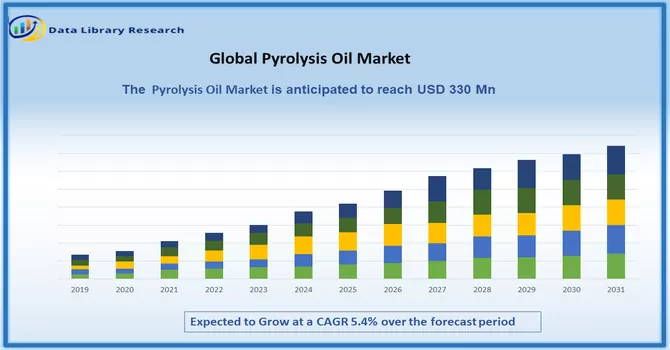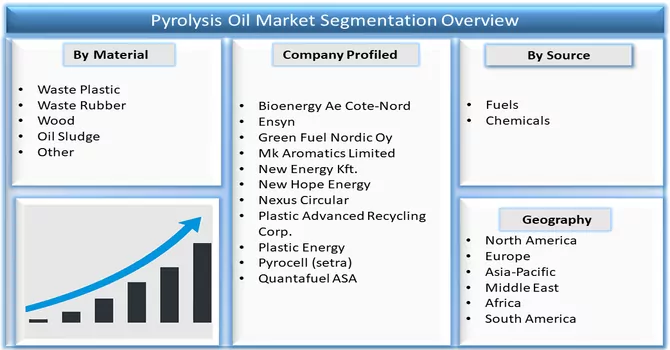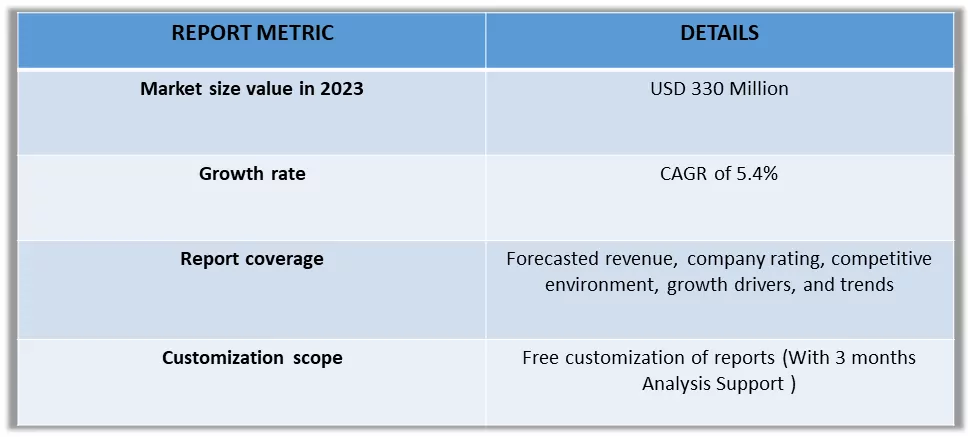The global pyrolysis oil market is estimated to reach over USD 330 million by the year 2024. It is projected to register a CAGR of over 5.4% during the forecasted period, 2024-2031

Get Complete Analysis Of The Report- Download Free Sample PDF
The global pyrolysis oil market is witnessing significant growth, driven by increasing emphasis on sustainable energy sources and a shift towards circular economy practices. Pyrolysis oil, also known as bio-oil, is derived from the thermal decomposition of organic materials, such as biomass or plastic waste, in the absence of oxygen. With rising concerns about environmental pollution and the depletion of traditional energy resources, there is a growing demand for alternative fuels. Pyrolysis oil, being a versatile energy carrier, finds applications in power generation, transportation, and various industrial processes.
Additionally, governments and organizations worldwide are investing in research and development to enhance the efficiency and scalability of pyrolysis technologies. Despite challenges related to economic viability and technological constraints, the market is poised for expansion, driven by a collective global commitment to reduce carbon footprints and transition towards sustainable energy solutions. A key driving factor propelling the growth of the global pyrolysis oil market is the increasing focus on sustainable energy solutions and the urgent need to address environmental concerns. Pyrolysis oil, derived from biomass and plastic waste through thermal decomposition, offers a renewable and eco-friendly alternative to conventional fossil fuels. The growing emphasis on reducing greenhouse gas emissions and combating climate change has heightened the demand for bio-based energy sources, positioning pyrolysis oil as a crucial player in the transition to cleaner energy. Government initiatives, stringent environmental regulations, and investments in research and development further contribute to the expansion of the pyrolysis oil market, providing a sustainable and economically viable solution for both energy generation and waste management.
Market Segmentation: The Global Waste-Derived Pyrolysis Oil Market is Segmented by Raw Material (Waste Plastic, Waste Rubber, Wood, Oil Sludge, and Other Raw Materials), Application (Fuels and Chemicals), and Geography (Asia-Pacific, North America, Europe, South America, and Middle East and Africa). The report offers market size and forecasts for pyrolysis oil in terms of revenue in USD million for all the above-mentioned segments.

For Detailed Market Segmentation - Download Free Sample PDF
The global pyrolysis oil market is witnessing several notable trends that are shaping its trajectory in the coming years. One prominent trend is the increasing adoption of advanced pyrolysis technologies to enhance the efficiency of oil production from various feedstocks, including biomass and plastic waste. This shift towards technological advancements not only improves the overall yield of pyrolysis oil but also addresses concerns related to process scalability and product quality.Moreover, there is a growing focus on the integration of pyrolysis oil into existing energy infrastructure, including refineries and power plants, as a means of diversifying the energy mix. This trend is driven by the recognition of pyrolysis oil as a versatile feedstock that can contribute to both bioenergy production and the circular economy by efficiently utilizing waste materials.Additionally, the market is experiencing an upsurge in strategic collaborations and partnerships among key industry players. These collaborations aim to leverage combined expertise, accelerate research and development initiatives, and foster innovations in pyrolysis technology. This collaborative approach is anticipated to result in more sustainable and economically viable solutions, aligning with the global push towards a circular and greener economy.Furthermore, consumer awareness and demand for sustainable products are influencing the market dynamics. The preference for environmentally friendly alternatives and the increasing implementation of stringent regulations related to carbon emissions are driving industries to explore and invest in pyrolysis oil as a cleaner energy source. As the global focus on sustainability intensifies, the pyrolysis oil market is poised to witness continued growth and innovation, positioning itself as a crucial player in the renewable energy landscape.
Market Drivers:
Rising Demand for Renewable Energy
One of the primary drivers for the global pyrolysis oil market is the increasing demand for renewable and sustainable energy sources. Pyrolysis oil, derived from biomass and organic waste, serves as an alternative to conventional fossil fuels. As nations strive to reduce their dependence on non-renewable resources and curb greenhouse gas emissions, the demand for pyrolysis oil as a renewable energy feedstock has witnessed significant growth. Governments and industries worldwide are incentivizing the adoption of pyrolysis technology to produce cleaner and more environmentally friendly energy solutions.
Waste Management Initiatives and Circular Economy Practices
The escalating global concern over waste management and environmental sustainability has propelled the adoption of pyrolysis oil as an integral component of circular economy practices. Pyrolysis processes can efficiently convert various waste streams, including plastic, rubber, and agricultural residues, into valuable pyrolysis oil. The emphasis on turning waste into a resource aligns with circular economy principles, driving the market for pyrolysis oil. Governments, businesses, and environmental organizations are increasingly supporting and investing in technologies that contribute to waste reduction, resource recovery, and the creation of a more sustainable and circular economy.
Market Restraints:
Market Restraints for the global pyrolysis oil market include technical and operational challenges, such as the need for advanced technologies and precise operational control, leading to variations in output. Economic viability poses a significant hurdle, with capital investments and operational costs impacting competitiveness against traditional fossil fuels. Regulatory and standardization hurdles also hinder growth due to varying standards across regions, creating uncertainties for producers. Addressing these challenges, such as optimizing the pyrolysis process, reducing costs, and establishing unified regulations, is crucial for the widespread adoption of pyrolysis oil and its integration into mainstream energy markets.
The global pyrolysis oil market experienced notable impacts from the COVID-19 pandemic. The disruptions in supply chains, restrictions on movement, and economic uncertainties led to a slowdown in industrial activities, affecting the demand for pyrolysis oil. Supply chain interruptions and logistical challenges further constrained the market, hindering the production and distribution of pyrolysis oil. Additionally, the economic downturn during the pandemic influenced investment decisions, potentially delaying projects related to pyrolysis oil production. As economies recover, the pyrolysis oil market is expected to gradually rebound, with a renewed focus on sustainable energy solutions driving its resurgence.
Segmental Analysis:
Waste Rubber Segment is Expected to Witness Significant Growth Over the Forecast Period
The waste rubber and pyrolysis oil market is gaining traction as industries and governments seek sustainable solutions for managing waste and reducing environmental impact. Pyrolysis is a process that converts waste rubber into pyrolysis oil, carbon black, and steel. Pyrolysis oil, also known as bio-oil or tire oil, has various applications, including as a fuel in industrial burners or boilers, or further refined into diesel or gasoline. One of the key drivers of the waste rubber and pyrolysis oil market is the increasing emphasis on circular economy principles and sustainable waste management practices. Pyrolysis offers a way to extract value from waste rubber that would otherwise end up in landfills or incinerated, reducing both waste volume and environmental pollution. Moreover, pyrolysis oil is considered a renewable energy source since it is derived from waste materials. This aspect aligns with global efforts to reduce reliance on fossil fuels and mitigate climate change. Governments and environmental agencies are also providing incentives and regulations to promote the use of pyrolysis oil as a sustainable alternative to conventional fuels. As the market for waste rubber and pyrolysis oil continues to grow, there is a significant opportunity for innovation and investment in technologies that can enhance the efficiency and scalability of pyrolysis processes. Overall, the waste rubber and pyrolysis oil market is poised for substantial growth as industries and governments increasingly prioritize sustainability and environmental stewardship.
Europe Region is Expected to Witness Significant Growth Over the Forecast Period
Europe currently leads the global pyrolysis oil market and is expected to maintain this position in the coming years. Pyrolysis oil in Europe finds diverse applications, including combustion in boilers, fueling engines and turbines, upgrading to transportation fuels, and serving as a renewable feedstock for chemicals and materials. Key industries in the region, such as steel, cement, and transportation, heavily rely on pyrolysis oil. France ranks as the third-largest crude steel producer in the EU, producing approximately 13.9 million tons in 2021, a 20% increase from 2020. Germany, on the other hand, is intensifying efforts to reduce carbon emissions and dependency on oil and gas imports, which accounted for 63.7% and 95% of their respective demands in 2021. The government is incentivizing biofuel production to decrease these imports. The United Kingdom has initiated guidance for biofuels and other substitutes, promoting the use of various biofuels and potentially increasing demand for pyrolysis oil. The market's potential in reducing plastic waste and meeting energy needs for heating applications presents a significant opportunity. Italian company Maire Tecnimont SpA's subsidiary, NextChem, securing a contract for an advanced recycling plant for municipal plastic waste in Europe further highlights the market's growth potential in the region. These factors collectively indicate a promising outlook for the pyrolysis oil market in Europe.

Get Complete Analysis Of The Report- Download Free Sample PDF
The analyzed market exhibits a high degree of fragmentation, primarily attributable to the presence of numerous players operating on both a global and regional scale. The competitive landscape is characterized by a diverse array of companies, each contributing to the overall market dynamics. This fragmentation arises from the existence of specialized solution providers, established industry players, and emerging entrants, all vying for market share. The diversity in market participants is underscored by the adoption of various strategies aimed at expanding the company presence. On a global scale, companies within the studied market are strategically positioning themselves through aggressive expansion initiatives. This often involves entering new geographical regions, targeting untapped markets, and establishing a robust global footprint. The pursuit of global expansion is driven by the recognition of diverse market opportunities and the desire to capitalize on emerging trends and demands across different regions. Simultaneously, at the regional level, companies are tailoring their approaches to align with local market dynamics. Regional players are leveraging their understanding of specific market nuances, regulatory environments, and consumer preferences to gain a competitive edge. This regional focus allows companies to cater to the unique needs of local clientele, fostering stronger market penetration. To navigate the complexities of the fragmented market, companies are implementing a range of strategies. These strategies include investments in research and development to stay at the forefront of technological advancements, mergers and acquisitions to consolidate market share, strategic partnerships for synergies, and innovation to differentiate products and services. The adoption of such multifaceted strategies reflects the competitive nature of the market, with participants continually seeking avenues for growth and sustainability. In essence, the high fragmentation in the studied market not only signifies the diversity of players but also underscores the dynamism and competitiveness that drive ongoing strategic maneuvers. As companies explore various avenues for expansion, the market continues to evolve, presenting both challenges and opportunities for industry stakeholders.
Some of the Key Market Players are:
Recent Development:
1) In May 2022, ArcelorMittal Mining Canada and BioÉnergie AE Côte-Nord Canada finalized a 3-year contract for the supply of 16 million litres of pyrolytic oil annually to the ArcelorMittal pellet plant. ArcelorMittal Mining Canada is a prominent steel and mining company, ranking among the top five global producers of iron ore products.
2) In May 2022, New Hope Energy and TotalEnergies announced plans to construct an advanced recycling facility in Texas. This plant aims to convert end-of-life plastic waste into a recycled feedstock. TotalEnergies has committed to purchasing a portion of this feedstock to produce virgin-quality polymers, which will be utilized in food-grade packaging.
Q1. What is the current Pyrolysis Oil Market size?
As per Data Library Research the global pyrolysis oil market is estimated to reach over USD 330 million.
Q2. At what CAGR is the market projected to grow within the forecast period?
Pyrolysis Oil Market is projected to register a CAGR of over 5.4% during the forecast period.
Q3. What are the factors driving the Pyrolysis Oil market?
Key factors that are driving the growth include the Rising Demand for Renewable Energy and Waste Management Initiatives and Circular Economy Practices.
Q4. Which Region is expected to hold the highest Market share?
Europe region is expected to hold the highest Market share.
Data Library Research are conducted by industry experts who offer insight on industry structure, market segmentations technology assessment and competitive landscape (CL), and penetration, as well as on emerging trends. Their analysis is based on primary interviews (~ 80%) and secondary research (~ 20%) as well as years of professional expertise in their respective industries. Adding to this, by analysing historical trends and current market positions, our analysts predict where the market will be headed for the next five years. Furthermore, the varying trends of segment & categories geographically presented are also studied and the estimated based on the primary & secondary research.
In this particular report from the supply side Data Library Research has conducted primary surveys (interviews) with the key level executives (VP, CEO’s, Marketing Director, Business Development Manager and SOFT) of the companies that active & prominent as well as the midsized organization
FIGURE 1: DLR RESEARH PROCESS

Extensive primary research was conducted to gain a deeper insight of the market and industry performance. The analysis is based on both primary and secondary research as well as years of professional expertise in the respective industries.
In addition to analysing current and historical trends, our analysts predict where the market is headed over the next five years.
It varies by segment for these categories geographically presented in the list of market tables. Speaking about this particular report we have conducted primary surveys (interviews) with the key level executives (VP, CEO’s, Marketing Director, Business Development Manager and many more) of the major players active in the market.
Secondary ResearchSecondary research was mainly used to collect and identify information useful for the extensive, technical, market-oriented, and Friend’s study of the Global Extra Neutral Alcohol. It was also used to obtain key information about major players, market classification and segmentation according to the industry trends, geographical markets, and developments related to the market and technology perspectives. For this study, analysts have gathered information from various credible sources, such as annual reports, sec filings, journals, white papers, SOFT presentations, and company web sites.
Market Size EstimationBoth, top-down and bottom-up approaches were used to estimate and validate the size of the Global market and to estimate the size of various other dependent submarkets in the overall Extra Neutral Alcohol. The key players in the market were identified through secondary research and their market contributions in the respective geographies were determined through primary and secondary research.
Forecast Model
